Temple Deities
Hinduism is one of the oldest faiths in the world, dating back over 5000 years. It teaches love, tolerance, peace, and respect for all, including other religions. Hinduism speaks of the One Supreme Divine but acknowledges that God is perceived in infinite forms. This gives different Hindu traditions and every individual the freedom to practice their beliefs and to worship in their own way. Hindu scriptures speak of the Divine as a triad (known as the Trimurthi) consisting of the Gods Brahma as Creator, Vishnu as Preserver and Shiva as Destroyer, together constituting the One Supreme God.
While these Gods represent the principles of Transcendence, Goddesses personify the necessary dynamic energy (Shakti) which permeates and animates the phenomenal universe.
Hindus also worship nature in the form of five elements of the universe – sun, earth, air, water, and space – required for our very survival. Hindu teachings and most practices are also in line with the conservation of ecological preservation of this planet. Aeons ago Hindu philosophers also realised the existence of major planets and their exact relative positions to the Sun. Worshipping these nine planets is also part of the Hindu faith.
As you stand before each murti in our Temple, meditate on the extensive and deep symbolism in each one – the positions of hands and arms, legs and feet, the objects that are worn and carried, their adornments, the form and position of each one, their divine vehicle, and more.
All are welcome to visit the Temple and witness the colourful rituals of worship. The Temple Committee periodically organises group educational tours of the Temple and speakers on the philosophy of Hinduism.
Our Deities

Shri Siddhi Vinayaka
Lord Ganesha, in the form of Shri Siddhi Vinayaka, is the presiding deity in the Shri Ganesha Temple and sits in the central shrine. The elder son of Lord Shiva, Ganesha is worshipped in 32 different names and forms (Murthis) in various parts of the world. Shri Siddhi Vinayaka is the giver of success and is associated with bountiful harvests and general abundance in life. He is also popularly known as Vigneswara, meaning remover of all obstacles. As such, every ritual in the Hindu tradition begins with His invocation, as does every project, initiative, undertaking and course of action.
Shri Ganesha Gayatri
Om Ekadanthaya vidmahe Vakrathundaya dheemahi Tanno danthi prachodayath.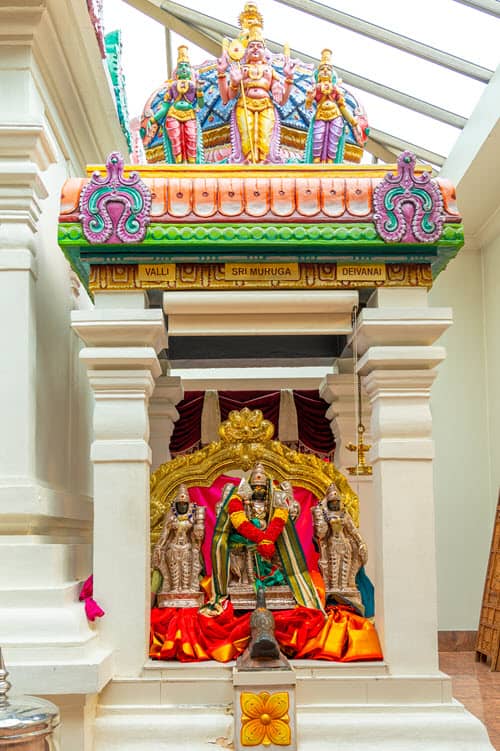
Lord Murugan with Shri Valli and Shri Deivanai
Lord Murugan, seated in the shrine on the right side of Shri Ganesha, is the younger son of Lord Shiva. He is the conjoint manifestation of Shiva and Shakti. Murugan is flanked by his consorts Valli and Deivanai who represent will (Valli) and action (Deivanai). He also holds a spear (Vel) given to him by his mother Shakti for subduing and transforming evil forces. The spear represents knowledge (Gyana). Thus, Lord Murugan and his consorts together denote the three cosmic energies of governing will, action and knowledge.
Lord Murugan Gayatri
Om Karthigeyaya vidmahe
Sakthi hastaya dheemahi
Tano Skanda prachodayath.
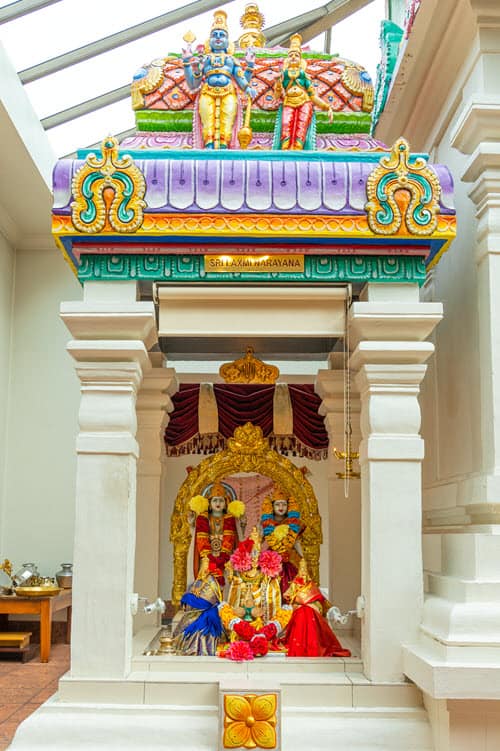
Shri Laxmi Narayan
Lord Vishnu, also known as Shri Narayan, is seated in the shrine on the left hand side of Lord Ganesha. He is the God of Preservation. His four hands hold a conch shell (Shankha), a discuss (Chakra), a lotus (Kamal) and a mace (Gadha). From time to time He manifests in the form of Avatars (incarnations) to win over evil and uphold virtue in the world. Shri Laxmi, his consort, is active energy, and the giver of prosperity, well-being, wealth and harmony.
Lord Narayan Gayatri
Om Narayanaya vidmahe
Vasudevaya dheemahi
Tanno Vishnu prachodayath.
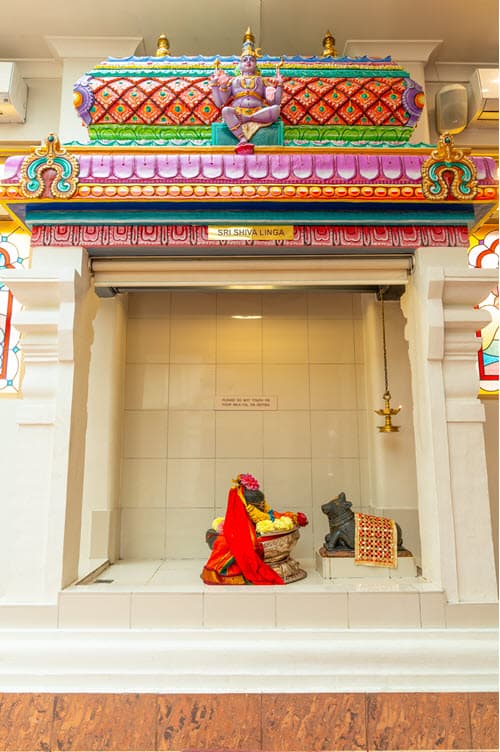
Shiva Linga
The Shiva Linga sits in the shrine on the right-hand side of the Temple. The Linga is a form of Lord Siva and represents the absolute God who is beyond all forms and qualities. The Linga consists of three parts: the base symbolising the place of Brahma (the Creator), the middle symbolising the place of Vishnu (the Preserver) and cylinder at the top symbolising the place of Shiva (the Destroyer, who clears the way for regeneration). Together they symbolize the merging of the micro-cosmos and macro-cosmos, the divine eternal process of creation and regeneration, and the three forms of universal energy that recreate all of existence.
Lord Siva Gayatri
Om Tatpuruṣhaya vidmahe
Mahadevaya dheemahi
Tanno Rudrah prachodayath.
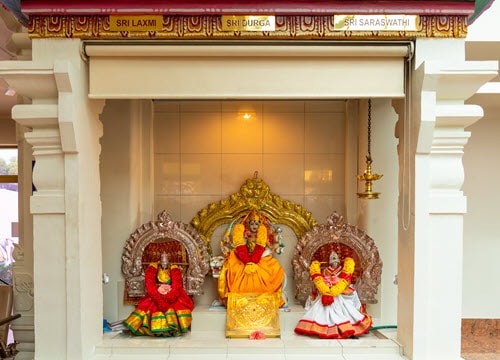
Goddesses Shri Durga, Shri Laxmi and Shri Saraswati
The three Goddesses are seated on the left-hand side of the main Temple area. Shri Durga is the divine cosmic force (Shakti), Shri Lakshmi is the Goddess of Wealth and Shri Saraswati the Goddess of Knowledge. Co-jointly they are the three major aspects essential for human survival and progress. These three Goddesses are prime among all the goddesses of the Hindu faith, and the status accorded to the Goddesses is unique to the Hindu religion.
Shri Durga Gayatri Mantra
Om Giri-jäyai cha vidmahe
Sivapriyäyai cha dheemahi
Tanno Käli pracodayäth.
Shri Lakshmi Gayatri Mantra
Om Mahalaxmiyei vidmahe
Vishnu Patniyai cha dheemahi
Tanno Lakshmi prachodayath.
Shri Saraswathi Gayatri Mantra
Om Vakdeviyai cha vidmahe
Virinji Pathniyai cha dheemahi
Tanno Vani prachodayath.

Lord Hanuman
Lord Hanuman is seated in a shrine in the alcove to the left of the main Temple area. He is the faithful devotee of Lord Rama – an incarnation of Lord Vishnu. He is the son of Vayu (the Wind God) and is revered for his immense physical strength, courage, persistence, and deep devotion. Lord Hanuman is considered the living embodiment of the Karma Yogi (one whose meditation and devotion are demonstrated through hard work and service). He features prominently in the epic poem of India, the Ramayana, which is a perennial source of spiritual, cultural and artistic inspiration.
Hanuman Gayatri Mantra
Om Aanjaneya vidmahe
Maha balaya dheemahe
Tanno Hanumata prachodayath.
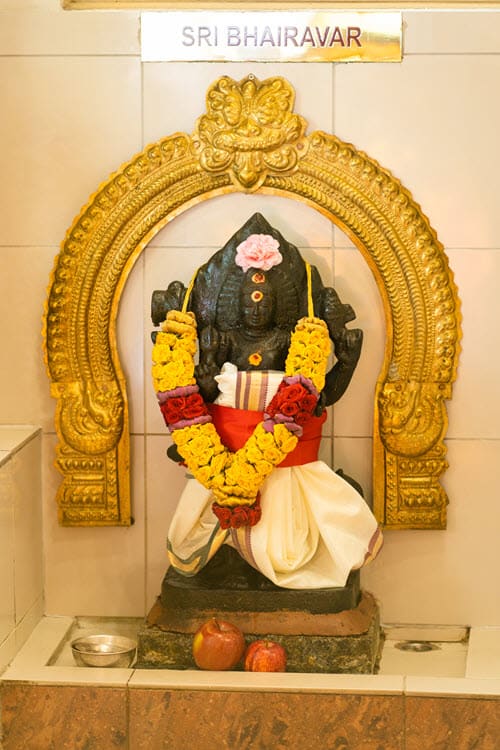
Lord Bhairava
Lord Bhairava is situated just to the left of the Navagraha (Planets) on the right-hand side of the Temple. He is a powerful and fierce manifestation of Lord Shiva who guards the Temple – as such he is found in all temples dedicated to Lord Siva – and destroys those who would do evil. Worshipping Lord Bhairava helps to overcome diseases, adversaries, enemies and poverty. In keeping with his fierceness, he wears a tiger skin and a ritual apron composed of human bones. In his four hands he carries a noose, trident, drum, and skull.
Bhairava Gayatri Mantra
Om Kaalakaalaaya vidmahe
Kaalaatheethaaya dheemahe
Tanno Kaala Bhairava prachodayath.
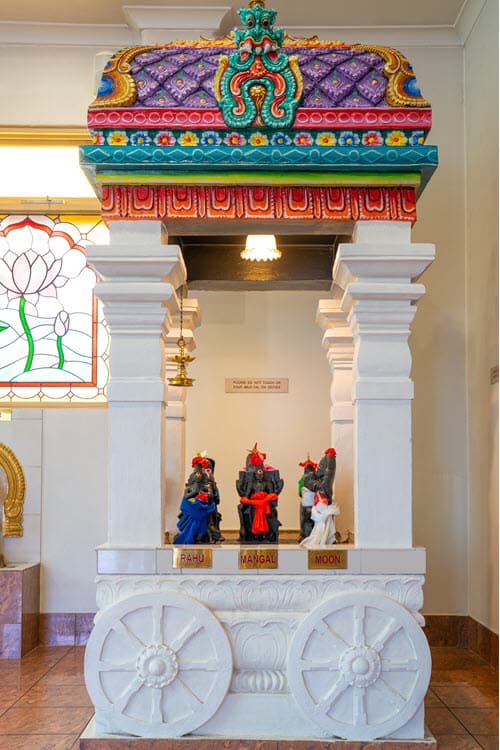
Navagraha (The Nine Planets)
The Navagraha refers to the nine planets that govern our destinies. The planets are Surya (Sun), Chandra (Moon), Mangal (Mars), Budha (Mercury), Guru (Jupiter), Shukra (Venus), Shani (Saturn), Rahu and Kethu. The latter two are the ascending and descending nodes of the moon. Navagraha are placed in the north-east corner of the Temple and arranged in a square so that they do not face each other.
Shri Siddhi Vinayaka

Lord Ganesha, in the form of Shri Siddhi Vinayaka, is the presiding deity in the Shri Ganesha Temple and sits in the central shrine. The elder son of Lord Shiva, Ganesha is worshipped in 32 different names and forms (Murthis) in various parts of the world. Shri Siddhi Vinayaka is the giver of success and is associated with bountiful harvests and general abundance in life. He is also popularly known as Vigneswara, meaning remover of all obstacles. As such, every ritual in the Hindu tradition begins with His invocation, as does every project, initiative, undertaking and course of action.
Shri Ganesha Gayatri
Om Ekadanthaya vidmahe Vakrathundaya dheemahi Tanno danthi prachodayath.Lord Murugan with Shri Valli & Shri Deivanai

Lord Murugan, seated in the shrine on the right side of Shri Ganesha, is the younger son of Lord Shiva. He is the conjoint manifestation of Shiva and Shakti. Murugan is flanked by his consorts Valli and Deivanai who represent will (Valli) and action (Deivanai). He also holds a spear (Vel) given to him by his mother Shakti for subduing and transforming evil forces. The spear represents knowledge (Gyana). Thus, Lord Murugan and his consorts together denote the three cosmic energies of governing will, action and knowledge.
Lord Murugan Gayatri
Om Karthigeyaya vidmahe
Sakthi hastaya dheemahi
Tano Skanda prachodayath.
Shri Laxmi Narayan

Lord Vishnu, also known as Shri Narayan, is seated in the shrine on the left hand side of Lord Ganesha. He is the God of Preservation. His four hands hold a conch shell (Shankha), a discuss (Chakra), a lotus (Kamal) and a mace (Gadha). From time to time He manifests in the form of Avatars (incarnations) to win over evil and uphold virtue in the world. Shri Laxmi, his consort, is active energy, and the giver of prosperity, well-being, wealth and harmony.
Lord Narayan Gayatri
Om Narayanaya vidmahe
Vasudevaya dheemahi
Tanno Vishnu prachodayath.
Shiva Linga

The Shiva Linga sits in the shrine on the right-hand side of the Temple. The Linga is a form of Lord Siva and represents the absolute God who is beyond all forms and qualities. The Linga consists of three parts: the base symbolising the place of Brahma (the Creator), the middle symbolising the place of Vishnu (the Preserver) and cylinder at the top symbolising the place of Shiva (the Destroyer, who clears the way for regeneration). Together they symbolize the merging of the micro-cosmos and macro-cosmos, the divine eternal process of creation and regeneration, and the three forms of universal energy that recreate all of existence.
Lord Siva Gayatri
Om Tatpuruṣhaya vidmahe
Mahadevaya dheemahi
Tanno Rudrah prachodayath.
Goddesses Shri Durga, Shri Laxmi and Shri Saraswati

The three Goddesses are seated on the left-hand side of the main Temple area. Shri Durga is the divine cosmic force (Shakti), Shri Lakshmi is the Goddess of Wealth and Shri Saraswati the Goddess of Knowledge. Co-jointly they are the three major aspects essential for human survival and progress. These three Goddesses are prime among all the goddesses of the Hindu faith, and the status accorded to the Goddesses is unique to the Hindu religion.
Shri Durga Gayatri Mantra
Om Giri-jäyai cha vidmahe Sivapriyäyai cha dheemahi Tanno Käli pracodayäth.Shri Lakshmi Gayatri Mantra
Om Mahalaxmiyei vidmahe Vishnu Patniyai cha dheemahi Tanno Lakshmi prachodayath.Shri Saraswathi Gayatri Mantra
Om Vakdeviyai cha vidmahe Virinji Pathniyai cha dheemahi Tanno Vani prachodayath.Lord Hanuman

Lord Hanuman is seated in a shrine in the alcove to the left of the main Temple area. He is the faithful devotee of Lord Rama – an incarnation of Lord Vishnu. He is the son of Vayu (the Wind God) and is revered for his immense physical strength, courage, persistence, and deep devotion. Lord Hanuman is considered the living embodiment of the Karma Yogi (one whose meditation and devotion are demonstrated through hard work and service). He features prominently in the epic poem of India, the Ramayana, which is a perennial source of spiritual, cultural and artistic inspiration.
Hanuman Gayatri Mantra
Om Aanjaneya vidmahe
Maha balaya dheemahe
Tanno Hanumata prachodayath.
Lord Bhairava

Lord Bhairava is situated just to the left of the Navagraha (Planets) on the right-hand side of the Temple. He is a powerful and fierce manifestation of Lord Shiva who guards the Temple – as such he is found in all temples dedicated to Lord Siva – and destroys those who would do evil. Worshipping Lord Bhairava helps to overcome diseases, adversaries, enemies and poverty. In keeping with his fierceness, he wears a tiger skin and a ritual apron composed of human bones. In his four hands he carries a noose, trident, drum, and skull.
Bhairava Gayatri Mantra
Om Kaalakaalaaya vidmahe
Kaalaatheethaaya dheemahe
Tanno Kaala Bhairava prachodayath.
Navagraha (The Nine Planets)

The Navagraha refers to the nine planets that govern our destinies. The planets are Surya (Sun), Chandra (Moon), Mangal (Mars), Budha (Mercury), Guru (Jupiter), Shukra (Venus), Shani (Saturn), Rahu and Kethu. The latter two are the ascending and descending nodes of the moon. Navagraha are placed in the north-east corner of the Temple and arranged in a square so that they do not face each other.